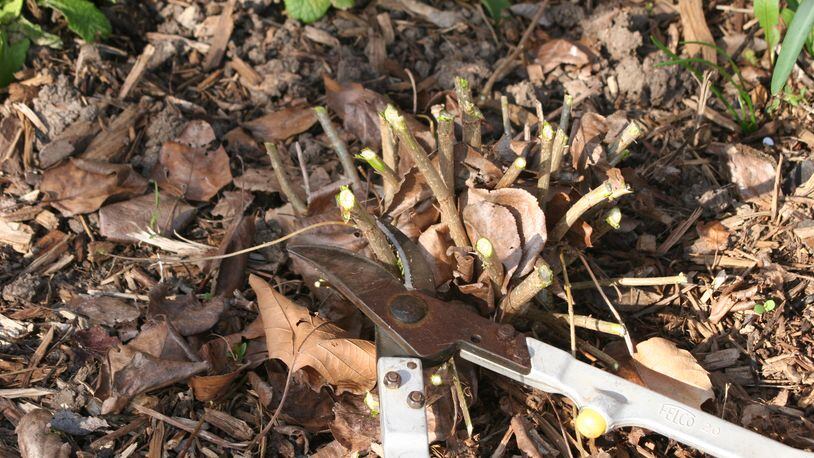One pruning task that I undertake every three or four years is rejuvenative pruning of overgrown shrubs. It’s easy, and there is very little thought required to rejuvenate an overgrown shrub.
Shrubs such as forsythia, viburnum, shrub dogwoods, hydrangeas that bloom on new wood (important to know which hydrangea you have), spiraea, and other deciduous shrubs that bloom in the SPRING can all be rejuvenated now.
Two important factors – this technique should only be used on deciduous plants (lose their leaves in the fall) and on those that bloom in the spring. These plants store their energy in their roots for the winter, therefore, rejuvenating them in the spring is perfect.
To rejuvenate an overgrown shrub completely, simply cut the entire plant back to the crown or close to ground level depending on the species.
Red-twigged dogwood, for instance, has suckers that sprout from all around the crown of the plant. I cut these as well as forsythias back to ground level.
Hydrangeas on the other hand, tend to have a single trunk. I cut the branches back to this trunk.
Spiraeas are so easy to rejuvenate that I use the sharp blade on my weed eater and cut them back to just above ground level. I do this every year on the smaller spiraeas in my perennial gardens so that they stay nice and compact.
The point is you don’t have to worry about making perfect cuts on shrubs that you are rejuvenating. Cut them back.
When the shrub starts to grow this spring, it puts all its stored energy into the new plant. Consequently, the plant is smaller but not overgrown and straggly.
From here, you can either prune it regularly to keep in check or rejuvenate it every so many years, which is what I do.
In addition, this is also a method of disease control. My red-twigged dogwood that I use for cut stems around the holidays, is susceptible to botryosphaeria canker. The stems turn brown and die.
To have nice red stems I tend to cut this plant back more often. Botryosphaeria usually affects the second-year growth.
Caution – rejuvenation can not be used on all shrubs. Do not use it on evergreen shrubs unless you want to wait a really really long time for them to recover. They store their energy in the foliage. Therefore, it’s tough for them to recover.
Credit: Contributed
Credit: Contributed
You may also want to rejuvenate older plants by only removing the older branches such as those of a lilac. Taking out the old branches allows new branches to continue to grow.
This is more of a challenge because the older branches are in the middle of the plant and sometime harder to get to, but it can be done.
Most importantly, when doing any pruning be sure to have sharp pruning tools to avoid tearing the branches.
Pamela Corle-Bennett is the state master gardener volunteer coordinator and horticulture educator for Ohio State University Extension. Contact her by email at bennett.27@osu.edu.
About the Author
